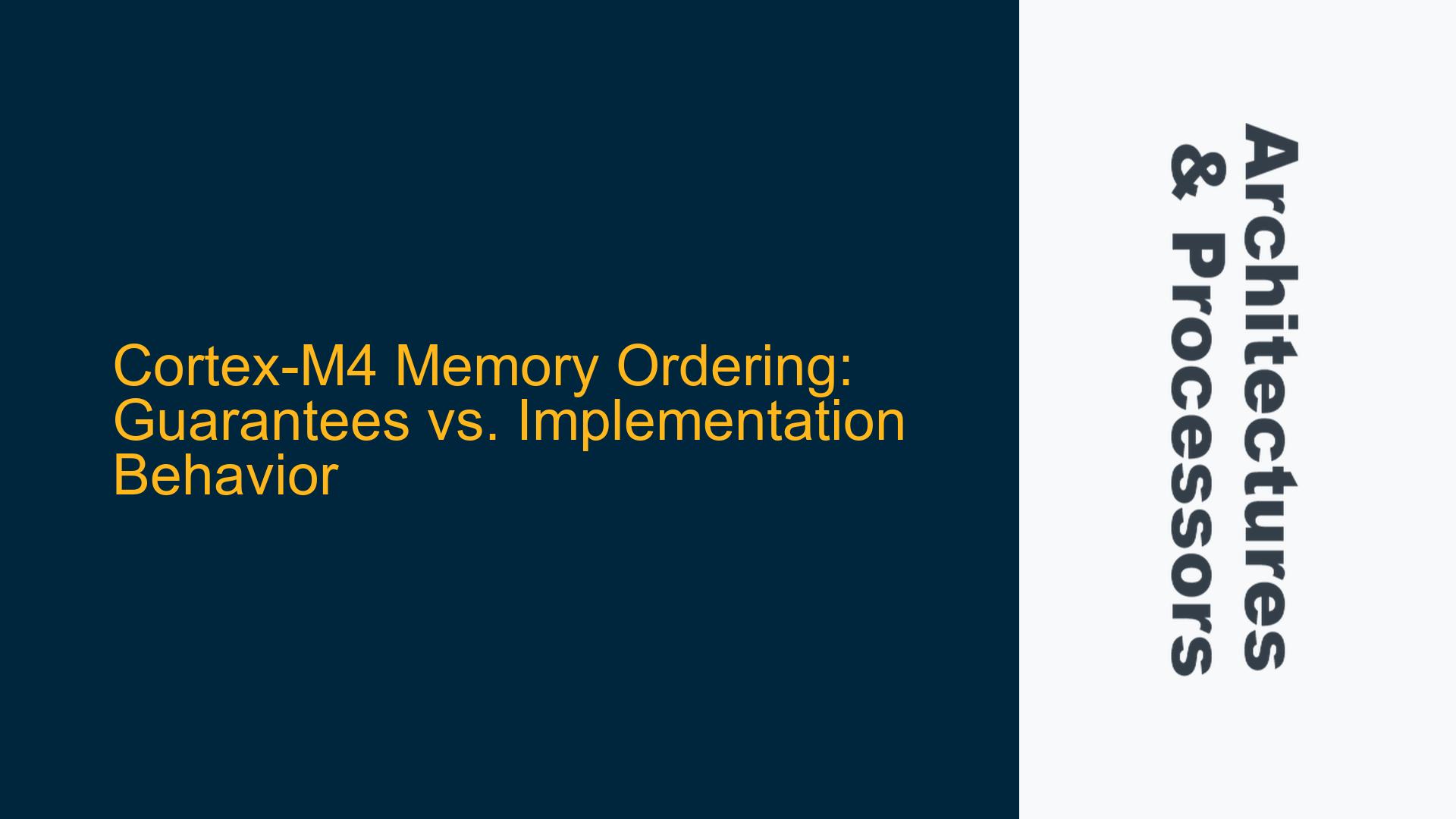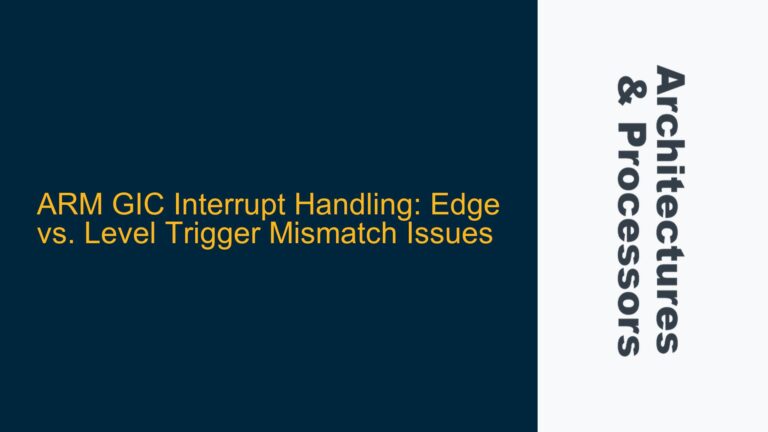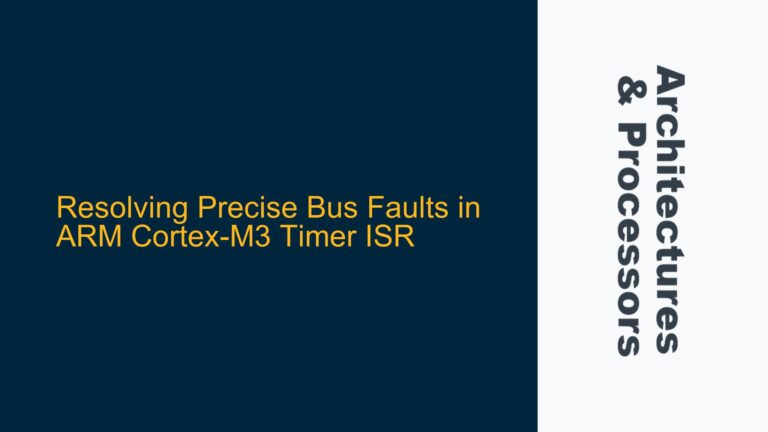ARM Cortex-M4 Memory Access Ordering: Architectural Guarantees vs. Implementation-Specific Behavior
The ARM Cortex-M4 processor, like other ARM Cortex-M series processors, is designed with a focus on deterministic real-time performance and low-latency interrupt handling. A critical aspect of its design is memory access ordering, which governs how the processor handles reads and writes to memory. The ARMv7-M architecture defines a set of rules for memory ordering, but there is often confusion between what is architecturally guaranteed and what is implementation-specific behavior. This post delves into the nuances of memory ordering in the Cortex-M4, clarifying the distinction between architectural guarantees and the practical behavior observed in the Cortex-M4 implementation.
The Cortex-M4 architecture ensures that memory accesses are generally performed in program order, meaning that instructions are executed in the sequence they appear in the code. However, the ARMv7-M architecture reference manual provides a table that describes the memory access ordering rules, which includes scenarios where memory accesses may appear out of order. This table is often misinterpreted, leading to confusion about whether the Cortex-M4 strictly adheres to program order or allows for out-of-order memory accesses under certain conditions.
The confusion is further compounded by documentation discrepancies. For example, the ARM Cortex-M Programming Guide to Memory Barrier Instructions (Application Note 321) states that Cortex-M processors never perform memory accesses out of order compared to the instruction flow, but it also notes that the architecture does not prohibit this in future implementations. On the other hand, the STM32 Cortex-M4 programming manual includes a table similar to the one in the ARMv7-M architecture reference manual, suggesting that out-of-order memory accesses are possible.
This discrepancy raises important questions: Is the Cortex-M4’s memory ordering behavior strictly defined by the architecture, or is it implementation-specific? How should developers design their software to ensure correct behavior across different Cortex-M implementations? To answer these questions, we must first understand the architectural guarantees provided by the ARMv7-M architecture and how they relate to the Cortex-M4’s implementation.
Memory Barrier Omission and Cache Invalidation Timing
The core of the issue lies in the distinction between architectural guarantees and implementation-specific behavior. The ARMv7-M architecture defines a set of memory ordering rules that allow for certain types of out-of-order memory accesses. These rules are designed to provide flexibility for future implementations while ensuring that software can rely on a minimum set of guarantees. The Cortex-M4, as an implementation of the ARMv7-M architecture, adheres to these rules but also exhibits behavior that goes beyond the architectural guarantees.
One of the key architectural guarantees is that memory accesses are generally performed in program order. However, the architecture allows for certain exceptions, such as reordering of writes to different memory locations or reads that do not have dependencies. These exceptions are documented in the memory access ordering table in the ARMv7-M architecture reference manual. The table uses symbols like "<" to indicate that one access must complete before another, and ">" to indicate that the order is not guaranteed.
In practice, the Cortex-M4 implementation does not perform out-of-order memory accesses. This means that the processor issues memory accesses in the same order as the instructions appear in the program. However, this behavior is not guaranteed by the architecture and may change in future implementations. This is why the ARM Cortex-M Programming Guide to Memory Barrier Instructions emphasizes that software should not rely on implementation-specific behavior and should instead use memory barriers to enforce ordering where necessary.
The omission of memory barriers in software can lead to subtle bugs, especially in systems with multiple processors or DMA controllers. For example, if a Cortex-M4 processor writes data to memory and then signals a DMA controller to read that data, the lack of a memory barrier could result in the DMA controller reading stale data. Similarly, cache invalidation timing can affect memory ordering, particularly in systems with caches or write buffers. If a cache line is invalidated after a write but before a read, the read may return incorrect data.
To avoid these issues, developers must understand the architectural guarantees and use memory barriers appropriately. Memory barriers ensure that all memory accesses before the barrier are completed before any accesses after the barrier. The Cortex-M4 provides several memory barrier instructions, including Data Synchronization Barrier (DSB), Data Memory Barrier (DMB), and Instruction Synchronization Barrier (ISB). These instructions can be used to enforce ordering and ensure correct behavior in multi-threaded or DMA-based systems.
Implementing Data Synchronization Barriers and Cache Management
To ensure correct memory ordering in Cortex-M4 systems, developers must implement data synchronization barriers and manage caches effectively. The Cortex-M4 provides a set of memory barrier instructions that can be used to enforce ordering and prevent out-of-order memory accesses. These instructions are essential for ensuring correct behavior in systems with multiple processors, DMA controllers, or caches.
The Data Synchronization Barrier (DSB) instruction ensures that all memory accesses before the barrier are completed before any accesses after the barrier. This is useful in scenarios where a processor needs to ensure that data is written to memory before signaling another device to read it. For example, if a Cortex-M4 processor writes data to a buffer and then signals a DMA controller to read the buffer, a DSB instruction should be used to ensure that the write is completed before the DMA controller starts reading.
The Data Memory Barrier (DMB) instruction ensures that all memory accesses before the barrier are completed before any memory accesses after the barrier, but only for memory accesses of the same type (e.g., reads or writes). This is useful in scenarios where a processor needs to ensure that writes to one memory location are completed before writes to another location. For example, if a Cortex-M4 processor writes data to a buffer and then updates a flag to indicate that the buffer is ready, a DMB instruction should be used to ensure that the write to the buffer is completed before the write to the flag.
The Instruction Synchronization Barrier (ISB) instruction ensures that all instructions before the barrier are completed before any instructions after the barrier. This is useful in scenarios where a processor needs to ensure that changes to the program counter or processor state are completed before executing subsequent instructions. For example, if a Cortex-M4 processor updates the program counter and then executes a branch instruction, an ISB instruction should be used to ensure that the update is completed before the branch is executed.
In addition to memory barriers, developers must also manage caches effectively to ensure correct memory ordering. The Cortex-M4 does not have a cache, but systems with caches or write buffers must ensure that cache lines are invalidated or flushed at the appropriate times. For example, if a Cortex-M4 processor writes data to a cache line and then signals a DMA controller to read the data, the cache line must be flushed to ensure that the DMA controller reads the correct data.
To summarize, the Cortex-M4’s memory ordering behavior is governed by the ARMv7-M architecture, which provides a set of rules that allow for certain types of out-of-order memory accesses. However, the Cortex-M4 implementation does not perform out-of-order memory accesses, and software should not rely on this behavior. Instead, developers should use memory barriers and cache management techniques to ensure correct behavior in multi-threaded or DMA-based systems. By understanding the architectural guarantees and implementing appropriate synchronization mechanisms, developers can avoid subtle bugs and ensure reliable system performance.






